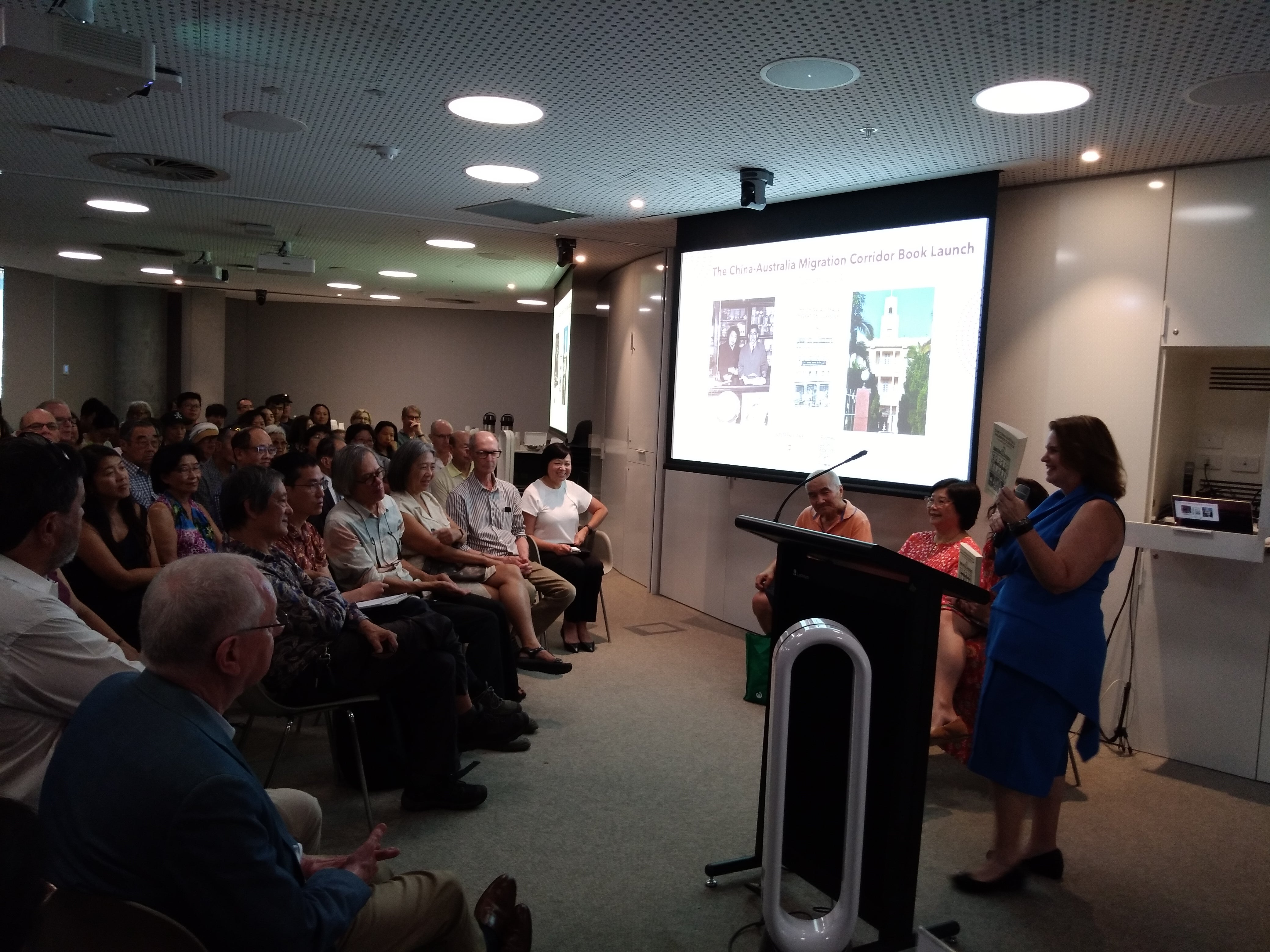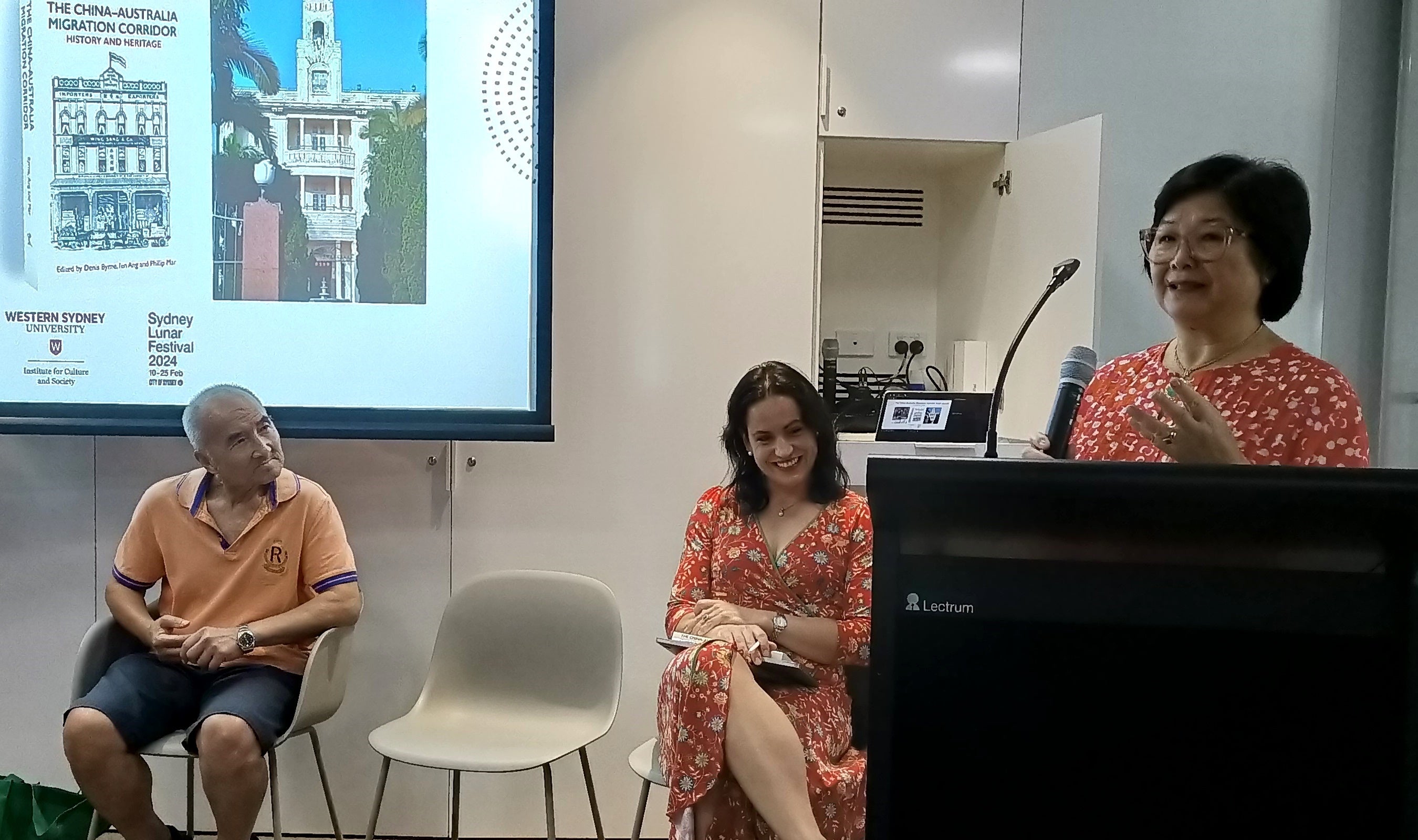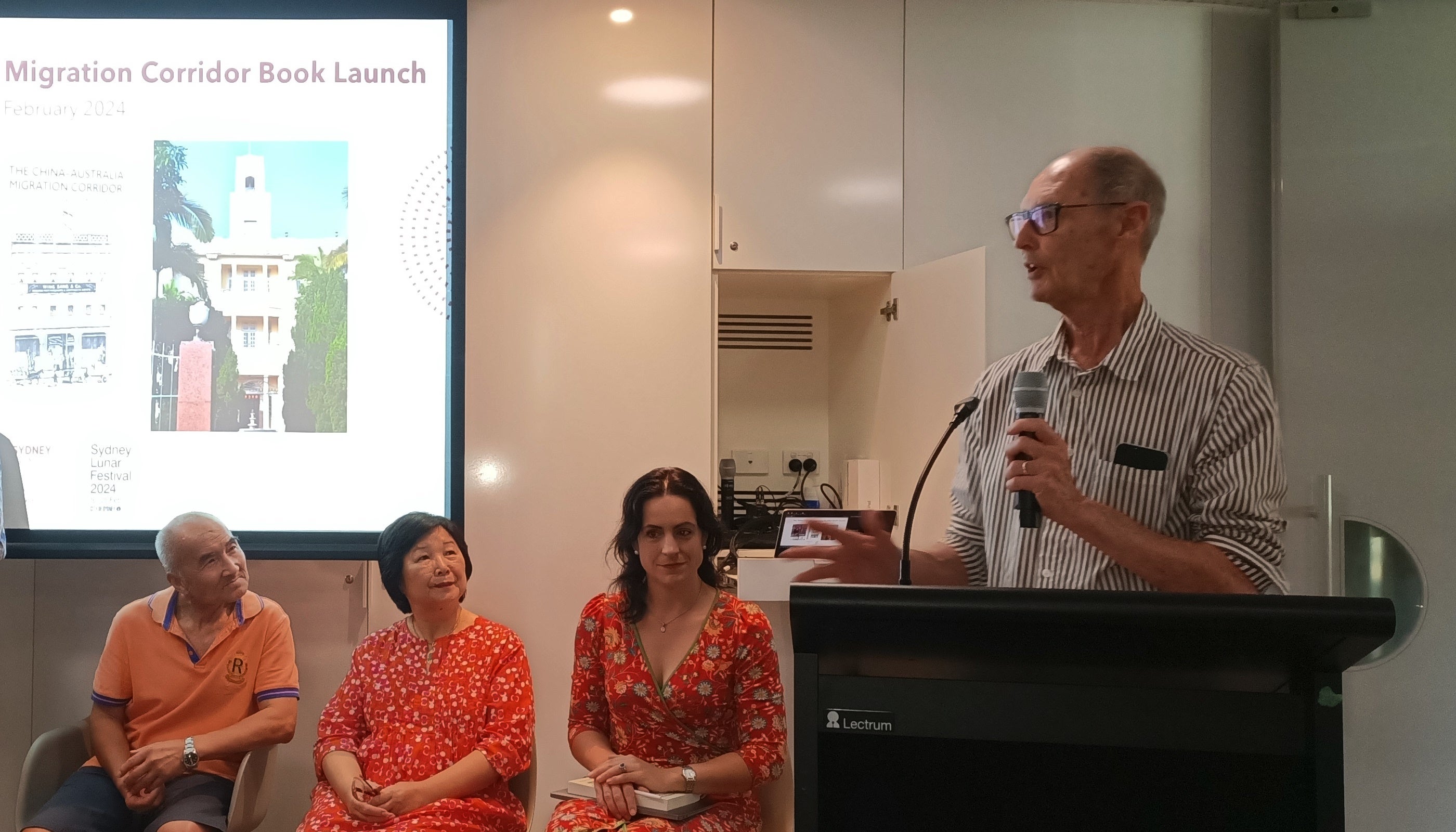
Resounding Success of ‘The China-Australia Migration Corridor’ Launch
The book launch of The China-Australia Migration Corridor: History and Heritage at Darling Square Library organised by the Institute for Culture and Society (ICS) at Western Sydney University, held on February 17, 2024, near Sydney’s Haymarket Chinatown. This City of Sydney Year of the Dragon event surpassed expectations, leading organisers to secure extra chairs and refreshments due to a remarkable turnout. The launch successfully overcame challenges encountered by history lecturers and booksellers in kindling interest. Its triumph went beyond being a mere book celebration; it stood as a testament to the infectious energy that transformed the launch into an unforgettable experience for all who attended.
Despite malfunctioning air-conditioning and a room designed for only 80 people, interest overflowed, with attendees both inside and outside the library, eagerly seeking the book for purchase on-site through local bookseller Gleebooks. High demand resulted in a near sell-out before guest speakers—Dr. Sophie Loy-Wilson, Ann Toy, and Douglas Lam—could finish their introductions, leaving some attendees thrilled with multiple autographed copies while others left empty-handed.
During our event, Dr. Sophie Loy-Wilson, the inaugural guest speaker and a historian specialising in Chinese Australian communities, highlighted the book’s ambition to go beyond national archives’ historical narratives, exploring the emotional terrain of Chung Shan (Zhongshan) Australian lives through oral history. Dr. Loy-Wilson applauded the collaborative effort between researchers and the community, viewing it as an exemplary model for engaged social research.
Outside the academic realm, the book strikes a powerful chord with descendants of migrants, as highlighted by our second guest, Ann Toy. She shared a personal journey, noting how, as an Australian-born Chinese (ABC) from Melbourne, she became disconnected from her roots, especially after her father’s passing during her childhood. Confronted with language barriers and the absence of knowledgeable elders, Ann stressed the profound impact of homeland tours and books like this in bridging the gap, filling a void in her understanding, and reconnecting her to her ancestral home of Toi Shan in Guangdong, China. It’s a story of rediscovery that adds a layer of depth to the broader narrative of migration and heritage.
Ann reminisced about the solace of enjoying a bowl of siu-lap rice in Sydney’s Chinatown over her 40-plus years in the city. She highlighted the invaluable assistance the book provided in uncovering previously unknown stories within Chinatown. Now, as a key supporter in preserving Kwong War Chong building’s fate and working toward transforming this distinctive Chinatown establishment—functioning as an integrated shop, remittance agent, lodging facility, family home, and social hub—into a community museum, Ann explained the book’s role in broadening her understanding of the transnational Chinese community and their important contribution to Sydney’s development.
The final guest, Douglas Lam, introduced by one of the book’s authors, Glenn Mar, emerged as a prominent figure in the book, embodying the spirit of the Sydney—Chung Shan heritage corridor. Douglas told stories that span multiple chapters, setting the tone for his engaging talk with a light-hearted remark about his water bottle devouring his notes. Reflecting on the cultural practice of sending money back to his family through Kwong War Chong, he stressed the role of remittances in both notifying them of his safe arrival in Sydney in 1961 and contributing to funds for ancestral worship. Douglas also highlighted details of his initiatives to assist community members in tracing their ancestors, including facilitating Glenn Mar’s family visit to Sha Chong village. A bonus of the event was Douglas’ presentation of the On Tong Lam Genealogy, collected during his most recent return to Chung Shan in December 2023, to Jacinta Leong, an attendee from Townsville.
The event, convened by ICS director Professor Heather Horst, drew notable figures, including Mr. King Fong, a five-term president of the Chung Shan Society of Australia, and numerous descendants of Chinese Australians, many of whom are featured in the book. Beyond the book’s editors, authors, and their colleagues from ICS, attendees comprised members of Chung Shan families, family historians, and descendants of founders and employees of Wing Sang, Sincere and The Sun Department Stores. Some travelled from interstate locations, such as Canberra, Melbourne, Gold Coast, and Townsville, highlighting the book’s broad appeal.
As I reflect on the cultural and historical significance of the book, the wise words of Janet Liu-Terry, my mentor, an editor and former university publisher, spring to mind. Before embarking on this transnational research project, she offered comforting advice, saying, “Quite often, researchers of Chinese Australian history hit a brick wall, but by overcoming language and geography, one enters a garden of infinite delight.” This sentiment perfectly encapsulates the importance of the research undertaken and the abundant rewards it can bring.
Ann Toy’s comments on the book’s potential to establish itself as a classic in Chinese Australian history, destined to enlighten future generations prompted her to re-read it already.

Excitement buzzes through Darling Square Library as the venue comes alive, filling up with anticipation just moments before the launch event is set to kick off. (Photo by Kiko Ko)

With great excitement, Professor Heather Horst proudly declares the launch of The China-Australia Migration Corridor: History and Heritage. Seated in the front row, the team of editors and authors, from left to right: Dr. Phillip Mar, Dr. Christopher Cheng, Glenn Mar, Professor Ien Ang, Professor Denis Byrne, and Dr. Alexandra Wong. (Photo by Kiko Ko)

Drawing on her past experiences and present endeavours, museologist and ABC Ann Toy speaks of the significance of the book. Also pictured are guest speakers, left to right: Douglas Lam and Dr. Sophie Loy-Wilson, absorbing every word. (Photo by Brad Powe, captions revised)

Interviewee Douglas Lam ad-libs from his life story after his leaky water bottle ‘ate’ his prepared notes. Also pictured are guest speakers, left to right: Ann Toy and Dr. Sophie Loy-Wilson listen with keen interest to Douglas’ impromptu storytelling. (Photo by Brad Powe, captions revised)

Project leader Professor Denis Byrne expresses heartfelt gratitude to all contributors to the Heritage Corridor research project, extending appreciation to individuals in both Australia and China. Guest speakers, left to right: Douglas Lam, Ann Toy, and Dr. Sophie Loy-Wilson lend their attentive ears. (Photo by Brad Powe, captions revised)

Dr. Sophie Loy-Wilson and Douglas Lam are engrossed in the captivating content of the book, while Jacinta Leong, in the foreground, maintains a watchful eye. (Photo by Kiko Ko)
About the New Book
Embark on an enthralling journey into Chinese Australian heritage and history, discovering the intricate web of family migration, diasporic tourism, and insights into migrant heritage within a vibrant transnational community! Initially published in 2022 as a solo endeavour by Professor Denis Byrne under the title The Heritage Corridor: A Transnational Approach to the Heritage of Chinese Migration, the research then took shape as a collaborative volume in the following year. The hardcover edition, Heritage and History in the China-Australia Migration Corridor was released by Hong Kong University Press in 2023; it was simultaneously printed by Melbourne University Press as The China–Australia Migration Corridor: History and Heritage.

This in-depth transnational study revolves around the Chung Shan Australian community, anchored in the migrant-reconfigured landscapes of New South Wales and Far North Queensland. It delves into the dynamic interplay between Guangdong roots and Australian lives, leading to the formation of a distinct heritage corridor shaped by multigenerational social and material exchanges resulting from migration. The edited volume is organised into two sections: “The Connections, Flows and Identities” and “Sites in the Heritage Corridor.” Overall, the volume offers a profound exploration of the China-Australia migration corridor’s history and heritage by seamlessly integrating the extensive scholarship and diverse perspectives from its contributing authors.
In the first part, “The Connections, Flows and Identities” the exploration begins with chapter 1, an investigation into the emergence and transformation of emigrant villages in the Fragrant Hills, the title paying homage to the historical name of the district of origin, known in Cantonese as “Heung San.” It involves a historical re-examination of recent literature, including works like One Bright Moon (2020), Bew Chip’s Register (2022), and South Flows the Pearl (2022), following the publication of Dr. Michael Williams’ PhD as Returning Home with Glory (2018). In Chapter 2, Professor Denis Byrne skilfully weaves Tim Ingold’s meshwork concept, illustrating Chinese Australian migrant life as an entanglement of “knots.” The exploration extends to diverse places integral to the stories – from Kwong War Chong in Sydney to Stanley Hunt’s ancestral home and school in Mashan village, Doumen district, and further to North Queensland sites in Cairns and Gordonvale, where Zheng Si-Hang’s grandfather Jang Tim lived, worked, and found his resting place. As the narratives unfold, these locations become intimately connected, forming a mesmerising web of heritage and history. Moving forward, Chapter 3, authored by Distinguished Professor Ien Ang, intricately delves into the construction of a migrant Chinese identity across time. This chapter builds on her extensive scholarship on the concept of Chineseness.
Moving to the second part, “Sites in the Heritage Corridor,” three chapters are co-authored contributions. Chapter 5 leads us on a personal familial journey from Sydney back to the ancestral village in Chung Shan. It recounts the experiences of two ABCs—Glenn Mar, viewed through the lens of a family historian, and his brother Dr. Phillip Mar, an anthropologist. In Chapter 7, co-authored by Dr. Phillip Mar and myself, Dr. Christopher Cheng, we summarise my doctoral research, emphasising Australian diasporic involvement and the lasting impact of diaspora-funded schools in Chung Shan during the twentieth century. Chapter 8 extends the groundwork laid by Professor Ien Ang and Dr. Alexandra Wong in their previous investigations of Chinatown, culminating in the publication of Chinatown Unbound (2019). This chapter delves into the past and present identities and activities of the Chung Shan community in Sydney’s Chinatown.
The closing chapter, Chapter 9, contributed by Professor Denis Byrne, a former heritage professional in the NSW government and now a university professor, contextualises how migrant heritage is perceived in Australia. It examines the distinction between official “heritage from above” and the actual experience of migrant families, termed “heritage from below.” The latter reflects personal quests to find and maintain houses and, by extension, communal buildings, such as schools, lineage halls, and temples in the ancestral home. This pursuit is interconnected with several chapters in the book, including Professor Byrne’s own examination of the typology of remittance houses (Chapter 6), Dr. Alexandra Wong’s exploration of diasporic tourism and homeland travel (Chapter 4), and my personal favourite – Chapter 5, narrating Jimmy Mar and his extended Australian family’s long-awaited return visit to the ancestral home led by the irrepressible Douglas Lam in 2015.

At 87 years young, Jimmy Mar beams with pride as he stands in front of his ancestral house in Sha Chong village, Chung Shan. (Courtesy of Glenn Mar in 2015)
If you haven’t already acquired a copy yet and wish to engage in this enriching exploration into Chinese Australian heritage and history, you can purchase a copy of the edited volume from your local bookshops or conveniently place an order online through Melbourne University Press < https://www.mup.com.au/books/the-chinaaustralia-migration-corridor-paperback-softback> or Hong Kong University Press < https://hkupress.hku.hk/Herit_His_CN%E2%80%93AUS_Migr_Cor>. This is a journey worth preserving on your bookshelf. Better yet, consider it as an inexpensive and meaningful gift to pass down to future generations. Grab your copy pronto, before they run out, as they did at the spectacular launch event.
More book launch photos:

(Photos by Ian Johnson)

(Photos by Ian Johnson)
